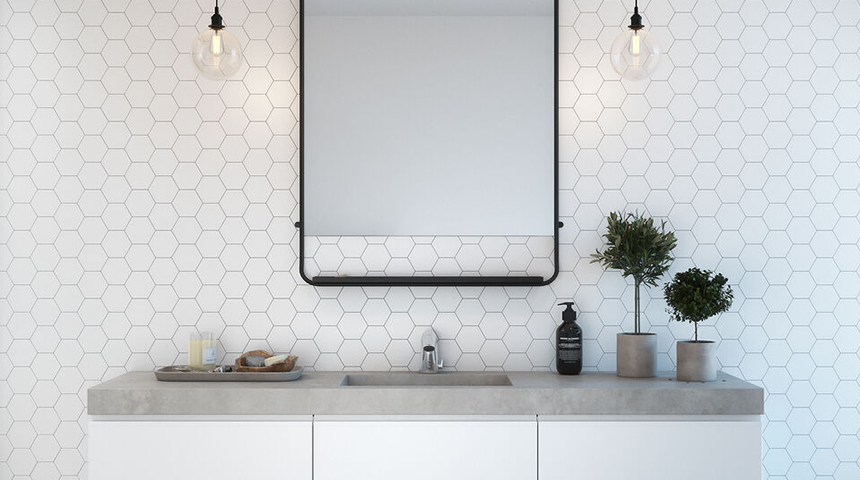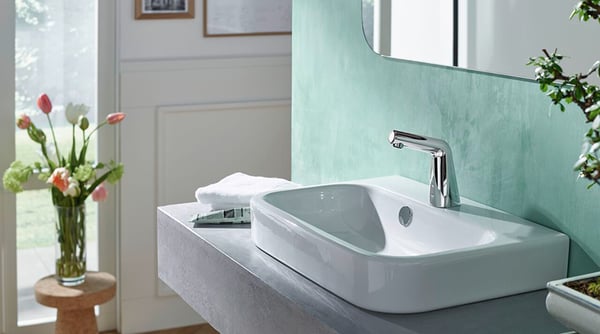In 2020 over 6 in 10 Europeans planned to renovate their bathrooms. Whether it’s by adding touch-free technologies or anti-bacterial surfaces, here are 5 simple upgrades that will help ensure your bathroom meets new standards of hygiene in the COVID era and beyond.

Every day, we spend a considerable amount of time in our bathrooms. In fact, it is estimated that, on average, we spend over two years in the bathroom — where over the course of a lifetime men shave for approximately 60 days and women enjoy showering for as many as 200 days.
And in the first half of 2020, as the world was stuck indoors under tight lockdown restrictions, interest in upgrading bathrooms spiked. Interior design company Houzz registered a 63% increase in the number of homeowners looking to renovate their bathrooms, compared to the same time in 2019.
Given the amount of time we all spend in this often-overlooked room, many figured it was time for an upgrade: because not only does a well-designed bathroom look good, it feels good too. And others may simply see it as a wise investment — a freshly renovated bathroom will increase the value of any home.
So, why wait? For you to get rolling, we gathered a list of upgrades to help you kick start your renovation efforts — whether it’s something you had in the works for a while, or you’re struck by sudden inspiration.
1. Add functional features
While we all dream of installing our very own hot tub, the coronavirus pandemic has got people turning to functional fixtures for their newly renovated bathrooms, especially hands-free technologies.
We know that touchless faucets, for example, can cut water consumption by half and reduce the spread of germs and bacteria. With 80% of the most common infectious diseases being transmitted by touch, installing hands-free fixtures in your new bathroom is a sensible start.
 Touchless faucets can cut water consumption by half and reduce the spread of germs and bacteria
Touchless faucets can cut water consumption by half and reduce the spread of germs and bacteria
2. Get some air
There is no doubt the past few months has us all paying more attention to the quality of the air we breathe. And, as we stubbornly keep windows open in our offices and living rooms, bathrooms can make use of a fresh breeze as well.
So, whether this means adding a window or a vent fan, it might depend on the home. But make sure to add features that ensure regular ventilation is an easy task.
3. Opt for anti-bacterial materials
Did you know that a number of materials we find in nature, including cork and linoleum, have natural anti-bacterial properties? And that solid surfaces built out of natural quartz can help prevent the formation of bacteria and mould?
If updating worn-out surfaces is a part of your plan (as we think it should be), opt for materials that naturally keep germs at bay without requiring constant sanitising.
4. Avoid wet floors
This might sound minor, yet wet floors happen to be hotbeds for bacteria (though not necessarily airborne viruses like coronavirus.)
To keep things on the safe side, here is what you can do to keep your floors dry: hang your towels close to the sink by adding hooks or racks close by and install splash guards on the bathtub or shower to prevent the floor from getting wet.
5. Add living space
Last but not least, why not ensure the bathroom turns into a better room altogether?
Given the amount of time we spend brushing our teeth, showering or even flipping through a magazine (a study found that over half its respondents enjoy reading in the bathroom) — prioritise adding that extra living space that allows you to move around more easily and make that read worthwhile.
Whether these ideas have just got you started or provided further insight for a project that’s well underway — we hope you can make use of a few of our tips.
Because while the end of the pandemic may be in sight, we are certain that a clean and well-designed bathroom will last for years to come.

-block-desktop-860x480.jpg?width=940&name=40210_Hansa_Vantis_Style_Basin01_Hansa_Vari_oh_IR.tif(1)-block-desktop-860x480.jpg)

-block-desktop-860x480%20(1).jpg?width=940&name=Oras_Romantic_V3.jpg(1)-block-desktop-860x480%20(1).jpg)


 Touchless faucets can cut water consumption by half and reduce the spread of germs and bacteria
Touchless faucets can cut water consumption by half and reduce the spread of germs and bacteria